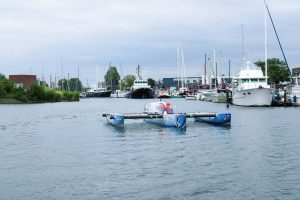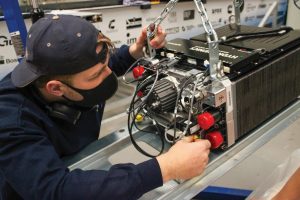By Andrew Bedggood
In a remarkable advance in boating technology, after previous teams of students from TU Delft (Delft University of Technology in the Netherlands) had concentrated on solar-powered boats, the 2021 team decided to switch their focus to hydrogen power.
The university team designed, produced, and tested an 8-metre trimaran, Hydro Motion. Equipped with three strong hydrofoils, a 70 hp three-phase, brushless electric motor capably raises the 1000+ kg boat, together with a crew of three, 40 cm above the water surface at a ‘take-off’ speed of 12 knots (22 km/h).
A 30 kW hydrogen fuel cell is given assistance from a small battery pack to achieve the initial lift. Once the hull is out of the water, water resistance is drastically reduced, so that much less energy is required to keep the boat moving. In testing, the fully crewed boat was able to reach speeds of up to 21 knots (nearly 40 km/h) and photos of the boat in action certainly make it appear to be flying.
Early in July, the university team entered their hydrogen-fueled boat in the 2021 Monaco Renewable Energy Boat Challenge. The boat acquitted itself well in the maneuverability challenge, but unfortunately encountered electrical problems during the coastal challenge. This prevented their participation in the long-distance competition the following day, which was disappointing because the team had already sailed for 6 hours non-stop, without refuelling, in trials on the open sea.
The Challenge attracted 32 teams wanting to showcase the latest innovations in boating using renewable energies. There were entries featuring solar, hydrogen, and even an electric-hydrogen hybrid. Many consider hydrogen power to be the future of boating.
One benefit of using hydrogen is that a large amount of energy can be stored, although it cannot be replenished as easily as recharging, say, lithium-ion batteries via solar panels while on the water.
The Hydro Motion has a 350-litre hydrogen tank, containing more than 8 kg of gas (265 kWh of energy yield) stored under high pressure rather than being liquefied.
Commercially, hydrogen is often produced either by thermal processes, where steam is passed through natural gas (or other hydrocarbon fuels), or by electrolysis where an electric current (perhaps produced by solar panels) is passed through water.
The Hydro Motion uses a Cummins HyPM-HD30 fuel cell to convert pure hydrogen into electricity to power the boat’s driveline, electronics, and other devices.
Hydrogen gas (H2) from the storage tank enters the fuel cell stack, separated from oxygen (O2) (present in the air) by a proton exchange membrane (PEM). The hydrogen breaks into negatively charged electrons and positively charged hydrogen ions (protons) within the fuel cell stack. The protons pass through the PEM, while the electrons travel around the PEM and through a wire, creating an electric current which is used to drive the boat’s motor, before returning to the fuel cell to complete the circuit. The hydrogen ions combine with oxygen to form water vapour – no CO2 is produced!
Published in print January-March 2022






























